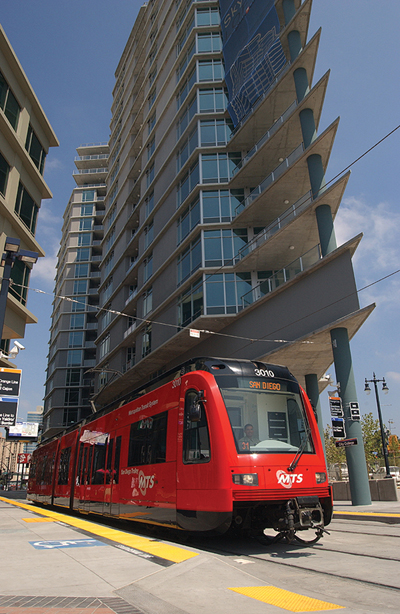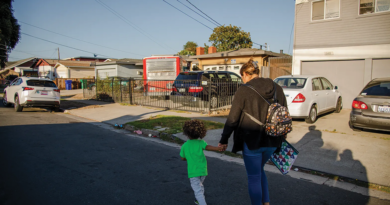Metropolitan Transit System named ‘Best of the Best’ Nationwide

By Kris Grant
This month Metropolitan Transit System (MTS) will pick up an award from the American Public Transportation Association (APTA) that names it the outstanding public transportation system of the year for agencies with more than 30 million trips in 2008.
The award will be accepted by MTS’s Chief Executive Officer Paul Jablonski at APTA’s annual meeting in Orlando, which will be attended by about 5,000 members. This past year the association held its convention and trade show in San Diego with close to 20,000 transportation administrators in attendance.
The award means MTS is “the best of the best,” said APTA President William Millar, “And that’s the best of the largest systems in North America.”
Jablonski and his management team will tell you it wasn’t an accident that MTS received the commendation. MTS consolidated the operations of three entities – San Diego Transit, the San Diego Trolley and the Metropolitan Transit Development Board – into one entity in 2005 and has been streamlining its operations continuously since the reorganization.
More than a dozen quantitative measures tallied over the past three years were figured into the award criteria measurements. MTS posted positive gains in most categories including ridership, up 12.3 percent; passengers per revenue hour, up 200 percent on some routes where MTS reallocated resources; on-time performance, up 6 percent and fare revenue, up 12 percent.
MTS also saw preventable accidents decline 14 percent, experienced 26.8 percent fewer driver-related complaints, saw subsidies per passenger fall 14.1 percent and saw a decrease in cost-per-revenue hour of 7 percent.
Over the past three years, MTS has replaced 224 of its vehicles, 88 of which are with environmentally-friendly engines, either compressed natural gas or gasoline-electric hybrids. And the new buses are better looking, sporting a new look with the red circle and wheel that replaced what used to be a bland blue and red stripe. You’ll also see colorful “wrap” advertising that brings in about $2.4 million in revenue annually.
What you won’t see is graffiti, with a zero-tolerance policy now in effect. “We get a lot of vandalism,” Jablonski admits. “Spray paint outside, slashing of seats inside. We immediately repair it. It has paid off with ridership increases and high customer satisfaction.”
Jablonski said the award is particularly noteworthy in that it was attained during a particularly challenging operating environment, with revenues diminished by the elimination of State Transit Assistance funding and by reduced consumer spending. (About half of MTS revenues depend on sales taxes.)
In 2003, Senate Bill 1703 ushered in a reorganization of public transit in San Diego, as with many parts of the state. “Previously, the primary focus of the Metropolitan Transit Development Board was to be a development board and what it mostly did was to build the trolley,” he said. “Tom Larwin, the executive director, was an engineer.”
The state Senate’s thinking was that since SANDAG was planning highways and roads, it should also plan for transit, Jablonski said. Today, SANDAG is responsible for long-range planning, while MTS operates the transit system.
Jablonski, who joined MTS in 2004, coming from a similar post as CEO of Cincinnati’s transit system, says that MTS is still in the planning business, but that its planning is more in the operations area, routes mostly. But there’s a lot that goes into that, he emphasizes and it can sometimes overlap and interface with the building sphere of SANDAG.
MTS operates a 54.3 mile light rail system network (the San Diego Trolley); 89 fixed bus routes and ADA Complementary Public Paratransit Service in the San Diego region. In fiscal year 2009, MTS set a system record of carrying 92 million passengers. That equates to 35 million to 36 million passengers per year, or 110,000 to 115,000 per day, on the trolley and about 56 million riders per year, about 170,000 per day, on the bus.
Jablonski said that MTS has “been on a track toward winning this award since 2004” and that the Comprehensive Operational Analysis (COA) of 2006, which was, in essence, a review of the entire route system, played a major role in achieving the numbers which brought home the award.
“When 9-11 happened, there was a significant downturn in the economy,” Jablonski recounted. “MTS was deficit spending in 2002, 2003 and 2004 about $14 or $15 million a year. “In that situation, you can raise fares or cut services to try to make some more money.
“But instead we decided to make sure that how we would spend money, would get us the biggest bang for the buck. We took a comprehensive look at the entire system. We put everything under a microscope and asked, ‘Does this make sense,” he said.
The first thing they looked at was routes, and Jablonski said there was what he calls a “lot of legacy stuff.”
“If you look at a particular bus route over 20 years, going from point A to point B, it changes over time. You might have a senior center built, so the bus company decides to alter the route by a couple of blocks to service the senior center. Then a business park develops a mile from the end of the line, and it’s decided to include it on the route. So over time routes change. There’s been so much development in San Diego especially that when you step back, you realize it gerrymanders all over the place.
“You can understand why someone would think, ‘Why should I spend an hour on the bus when it takes me 15 minutes to drive?’”
MTS also looked for areas it terms “ridership rich,” which turned out to be Hillcrest and the east part of the city. “We said, ‘Let’s take some services that aren’t doing well and reinvest them where we know transit does well,” Jablonski said. The COA provided us more services where there were rich bus markets, and positioned us to carry more people.”
MTS ended up changing 95 percent of its bus routes in phases over two years. “We did a heck of a lot of communications and public outreach to community groups and on station platforms,” Jablonski recalled. “We set up easels and we talked to people about the system.
“Ridership went up 6 to 8 percent immediately. Just from shifting our existing resources around.”
There was some push-back in areas that lost service. “But we said, you know, we just can’t afford to operate in areas where it costs us $25 per passenger,” Jablonski said.
Jablonski noted that the on-time performance went up by 6 percent, even allowing for a 55 percent increase in wheelchair deployments, which require additional time for loading disabled passengers.
Concurrently, the COA looked at ways to cut operating costs, and found that a major cost savings would be to contract out some of its services. “Some of our entities have been doing it for quite some time,” Jablonski says. Today, San Diego Transit runs its own buses from Downtown to points north and contracts out other areas.
The major subcontractor is Veolia, which services primarily the South Bay and East County and commuter express buses up I-15 and saves MTS about $19.4 million annually a year. Overall, contracted services account for a $20 million to $25 million savings per year. Southland is the contractor that handles the Sorrento Valley Coaster shuttle, and routes out to Poway and Point Loma; First Transit provides access services for people with disabilities.
Much of public transit has historically been subsidized, and today the “fare-box recovery” ratio is 44 percent recovery for buses and 60 percent for the trolley. The largest source of funds comes from the state Transportation Development Act, a sales tax that was enacted locally by the County Board of Supervisors. “That’s firewalled,” said Jablonski. “The state can’t touch it.” There also is Federal money for capital expenditures and maintenance.
There was another source, the State Transportation Assistance funds of $30 million a year. “It’s gone,” said Jablonski. “They cut it by 50 percent two years ago and the rest last year. A second problem is that our biggest money comes from sales tax and as people cut back on spending, sales tax revenue goes down. The biggest component of sales tax is automobile sales and that’s down at the state and local levels.”
There is also TRANSNET funding – a local half-cent sales tax that goes to highway funding, transit funding and local streets and roads. But the majority of that money goes into new projects, the mid-coast light rail line that will go to UCSD, and the super-loop (a dedicated bus route in the University Towne Center/UCSD area)
To cope with the loss of subsidies, MTS’s reorganized system created a situation where “We carry a lot more people. And when gas prices went up we carried even more people, which helped us off set the loss,” Jablonski said. “We had the capacity and the ridership increase to absorb the loss and on top of that we raised fares.
“Management can take some credit but this was an award deserving of all employees,” Jablonski said. “When we break down every 12,000 miles rather than 2,500, when we have better passenger relations; when we don’t get into altercations – it takes a lot of effort by a lot of people to raise the bar significantly.” z



